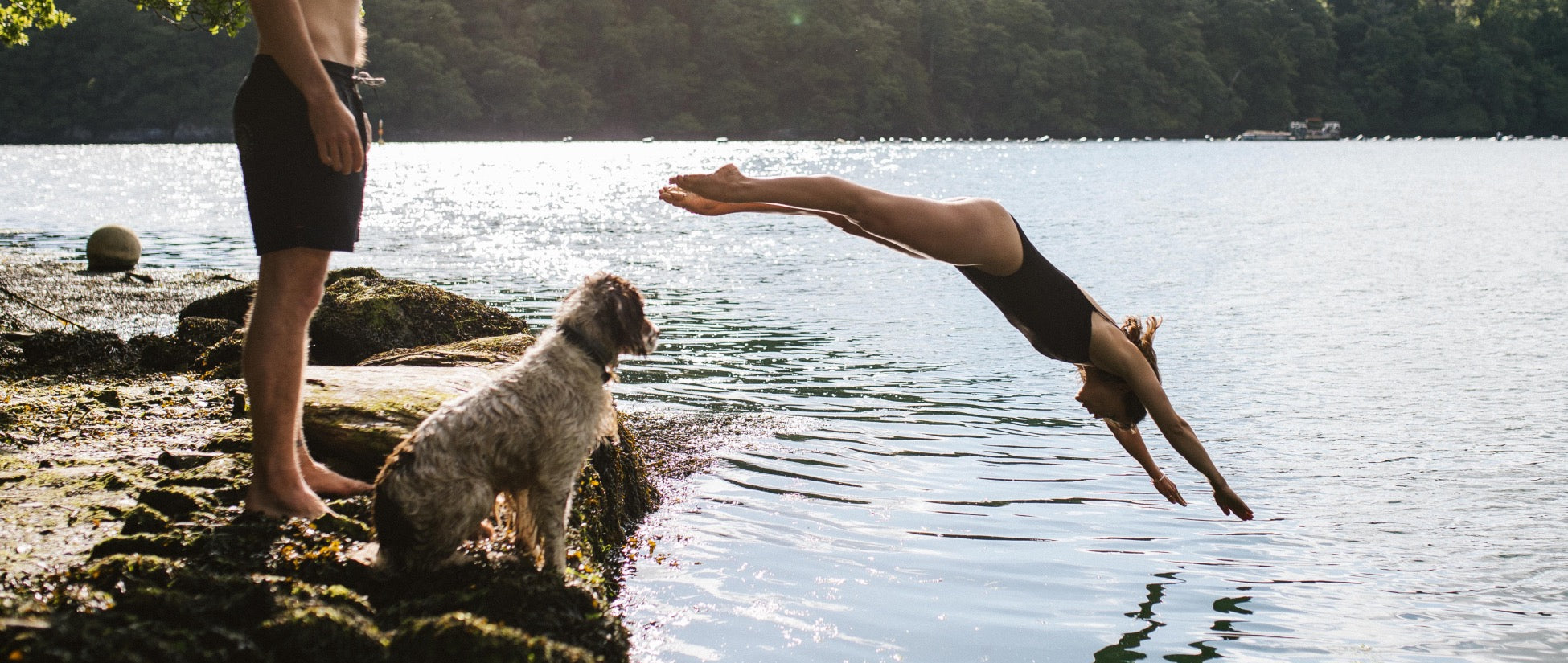The first signs of Spring have us looking ahead to milder and brighter days. We all find escapism in different ways, whether it’s following the rising sun or dipping in and out of the cold water of a tidal pool, often what it’s about is seeking natural rhythms to align ourselves with.
On the topic of cold water dipping, we caught up with Laura of Wild Swim Wales to chat all things wild swimming. Grab your changing robe and let’s dive in…

Laura, how did you first get into wild swimming, and what was your first experience?
As a surfer, I’ve always loved spending time in the ocean. The first time I went for a ‘wild’ sea swim was pretty scary because I was so used to having the safety of my surfboard. Once I let go of the fear of being surrounded by the vastness of the ocean (and the creatures below!) I began to love it and swam daily when I was lucky enough to live right by the sea in Aberystwyth.
These days, as I live close to the Bannau Brycheiniog, most of my outdoor swims are in freshwater rivers and lakes, which is a completely different experience from sea swimming. I also have an ice bath barrel in the garden and have been practising daily cold water immersion to build up my resilience.

What do you think are the top benefits of wild swimming?
I know there are many physical benefits to outdoor swimming, for instance, cold water exposure helps boost your body’s healing properties, strengthening your immune system and reducing your risk of cardiovascular disease.
But for me, the mental health benefits have always come top. Scientists believe there are large concentrations of negative ions around moving bodies of water and these negative ions release serotonin in us, which essentially reduces stress and makes us happy! It’s really quite simple.

I also think whilst you’re experiencing the cold and concentrating on your breathing, it’s very hard to think of anything else, so it’s a great relief from the stresses of everyday life.
You’ll also hear a lot of people talk about improving resilience when it comes to cold water immersion too, because exposing yourself to the discomfort of the cold can help with handling stress in the long run.


How do you stay safe when wild swimming, what precautions do you take?
Whether you’re swimming in the sea or taking a dip in an inland body of water, there are of course a number of real dangers to watch out for, from riptides to algae. That’s without naming some of the most obvious risks, including drowning and cold water shock.
To stay safe, I always:
-
Research where to swim beforehand and get to know the spot. I ask other swimmers if they’ve been there before and if there’s anything I should be aware of.
-
Let someone know where I am or take a buddy with me. I rarely go outdoor swimming alone - regardless of how experienced you might be, you never know when you might get into trouble.
-
Assess the location before entering, including looking for riptides, safe entry points, assessing the flow of water etc. If there’s anything I feel unsure about, I don’t go in.
-
Wear the right gear for the conditions, whether that’s gloves and boots, or a tow float to alert boats of my presence.
-
Stay within my limits. For instance, only staying in for a few minutes if it’s really cold.
- Dry off and warm up properly afterwards. Dressing quickly, wearing lots of layers and a hat, keeping moving and drinking a hot drink. This is crucial as your body’s temperature continues to drop after you’ve exited the water. This is called ‘after drop’.

In all your time wild swimming, where are your top 3 spots?
When it comes to wild swimming, everyone knows you never give away your favourite spots! Some people may call this ‘gatekeeping’, but it’s an essential secret rule in our outdoor swimming community to preserve our most precious landscapes.
Too many beautiful wild swim locations have been spoilt due to littering, overcrowding and trespassing. Having said this, there are some better-known locations I’d be happy to share with the wonderful Passenger community, including:
-
Llyn y Fan Fawr in the Bannau Brycheiniog. There’s a beautiful walk to a large lake here - head up to the ridge for a view of the Bannau Brycheiniog, including Pen y Fan if you’re lucky!
-
Rotherslade on Gower, Swansea. A gorgeous beach to take a dip at high tide, with a lovely coffee for warming up afterwards.
- The Watkin Pools in Eryri. This has become really popular in recent years, but it’s no wonder as it’s one of the clearest outdoor swimming pools and is a wonderful way to cool down on your way down from summiting yr Wyddfa!

Finally, any tips for first-time wild swimmers?
My top tips for beginners would be:
-
Give it a go in the summer when the water temperature is at its highest, then keep at it so you can acclimatise to the colder temperatures throughout the winter.
-
If you have to, wear gloves and/or boots or a wetsuit, you do what feels the most comfortable for you. It doesn’t make you any less of a ‘wild swimmer’!
- And lastly, enjoy it and stay safe. It’s all about being out there in nature and improving your physical and mental health.

Keep up with @WildSwimWales on Instagram for tips on wild swimming, how to find the best spots and general cold water realness.
Here's our pick of Sherpa lined changing robes to keep you warm after a cold dip:

Share:
Hidden Gems in the Canadian Rockies: A Winter Expedition to the Saskatchewan Glacier
Made To Roam: Backpacking Essentials Checklist